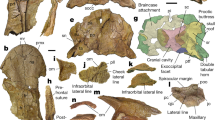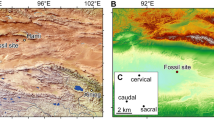Abstract
DURING the last few decades it has become increasingly clear that theTetrapods were derived from a group of fishes having their closest affinities with the Devonian Crossopterygii and Dipnoi. In 1932, Save-Soderbergh published a valuable description1 of some fossils, from the “Upper Devonian” of East Greenland, which afford a valuable bridge between the Crossopterygii and the Carboniferous Stegocephalians. These forms, the Ichthyostegalia, are much closer to the Stegocephalians than to the Crossopterygii in structure. The homology of most of their bones, in terms of the normal Tetrapod skull, is clear ; but Säve-Söderbergh, when comparing the Ichthyostegid skull with that of the Crossopterygii, found it necessary to adopt a very cumbersome modification of the terms used in the description of the latter group. The nomenclature adopted had a praiseworthy intention, to indicate the homologies of the comparatively specialized Tetrapod skull on the basis of the structure of generalized fossil fishes. Unfortunately, the nomenclature of the fishes concerned is based on Tetrapod names, which have largely been misapplied in fishes. As a result of this, the Tetrapod parietal and post-parietal were regarded by Säve-Söderbergh as “fronto-parietal” and “parieto-extrascapular”, and a number of other changes was suggested. Säve-Süderbergh recognized two bones in the place of the Tetrapod pre-frontal, and his attempts to find these elements in higher Stegocephalia2. have led to further complications. I have suggested3 that the Tetrapod parietal contains no part of the Cross-opterygian “parietal“, but is represented in the ”frontal“ of such a fish as Osteolepis ; and more recently I have directed attention4 to theprobable errors in homology made by Säve-Süderbergh in the supra- and pre-orbital regions.
This is a preview of subscription content, access via your institution
Access options
Subscribe to this journal
Receive 51 print issues and online access
$199.00 per year
only $3.90 per issue
Buy this article
- Purchase on Springer Link
- Instant access to full article PDF
Prices may be subject to local taxes which are calculated during checkout
Similar content being viewed by others
References
Säve-Söderbergh, G., Medd. om Grønland, 94, nr. 7 (1932).
Säve-Söderbergh, G., Medd. om Grønland, 98, nr. 3 (1935).
Westoll, T. S., Geol. Mag., 73, 164 (1936).
Westoll, T. S., Geol. Mag., 74, 517 (1937).
Westoll, T. S., Geol. Mag., 74, 520 et seq. (1937).
Author information
Authors and Affiliations
Rights and permissions
About this article
Cite this article
WESTOLL, T. Ancestry of the Tetrapods. Nature 141, 127–128 (1938). https://doi.org/10.1038/141127a0
Published:
Issue Date:
DOI: https://doi.org/10.1038/141127a0
This article is cited by
-
Elpistostege and the origin of the vertebrate hand
Nature (2020)
-
Evolution of the vertebrate skeleton: morphology, embryology, and development
Zoological Letters (2015)
-
The Fish–Tetrapod Transition: New Fossils and Interpretations
Evolution: Education and Outreach (2009)
-
A firm step from water to land
Nature (2006)
-
A Devonian tetrapod-like fish and the evolution of the tetrapod body plan
Nature (2006)
Comments
By submitting a comment you agree to abide by our Terms and Community Guidelines. If you find something abusive or that does not comply with our terms or guidelines please flag it as inappropriate.



